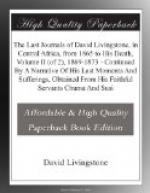Though reasonably willing to gratify curiosity, it becomes tiresome to be the victim of unlimited staring by the ugly, as well as by the good-looking. I can bear the women, but ugly males are uninteresting, and it is as much as I can stand when a crowd will follow me wherever I move. They have heard of Dugumbe Hassani’s deeds, and are evidently suspicious of our intentions: they say, “If you have food at home, why come so far and spend your beads to buy it here?” If it is replied, on the strength of some of Mohamad’s people being present, “We want to buy ivory too;” not knowing its value they think that this is a mere subterfuge to plunder them. Much palm-wine to-day at different parts made them incapable of reasoning further; they seemed inclined to fight, but after a great deal of talk we departed without collision.
9th November, 1869.—We came to villages where all were civil, but afterwards arrived where there were other palm-trees and palm-toddy, and people low and disagreeable in consequence. The mountains all around are grand, and tree-covered. I saw a man with two great great toes: the double toe is usually a little one.
11th November, 1869.—We had heard that the Manyuema were eager to buy slaves, but that meant females only to make wives of them: they prefer goats to men. Mohamad had bought slaves in Lunda in order to get ivory from these Manyuema, but inquiry here and elsewhere brought it out plainly that they would rather let the ivory lie unused or rot than invest in male slaves, who are generally criminals—at least in Lunda. I advised my friend to desist from buying slaves who would all “eat off their own heads,” but he knew better than to buy copper, and on our return he acknowledged that I was right.
15th November, 1869.—We came into a country where Dugumbe’s slaves had maltreated the people greatly, and they looked on us as of the same tribe, and we had much trouble in consequence. The country is swarming with villages. Hassani of Dugumbe got the chief into debt, and then robbed him of ten men and ten goats to clear off the debt: The Dutch did the same in the south of Africa.
17th November, 1869.—Copious rains brought us to a halt at Muana Balange’s, on the banks of the Luamo River. Moerekurambo had died lately, and his substitute took seven goats to the chiefs on the other side in order to induce them to come in a strong party and attack us for Hassani’s affair.
20th to 25th November, 1869.—We were now only about ten miles from the confluence of the Luamo and Lualaba, but all the people had been plundered, and some killed by the slaves of Dugumbe. The Luamo is here some 200 yards broad and deep; the chiefs everywhere were begged to refuse us a passage. The women were particularly outspoken in asserting our identity with the cruel strangers, and when one lady was asked in the midst of her vociferation just to look if I were of the same colour with Dugumbe, she replied with a bitter little laugh, “Then you must be his father!”




